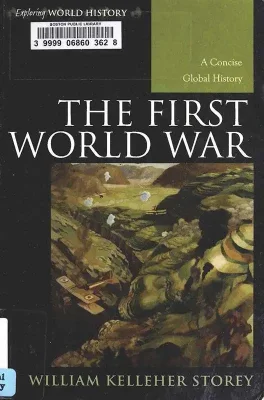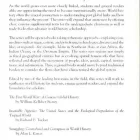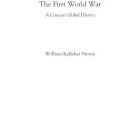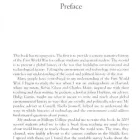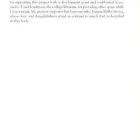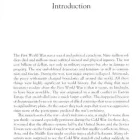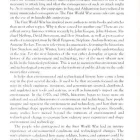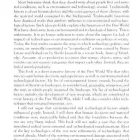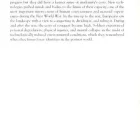- Military Library
- Literature
- WWI Books
- The First World War (published 2009)
The First World War (published 2009)
A Concise Global History
This book has two purposes. The first is to provide a concise narrative history of the First World War for college students and general readers. The second is to present a global history of the war that highlights environmental and technological factors. Taking the environment and technology into account enriches our understanding of the social and political history of the war.
The First World War was a social and political cataclysm. Nine million soldiers died and millions more suffered mental and physical injuries. The war cost billions ot dollars, not only in military expenses hut also in damage to property. The war emboldened democrats and feminists as well as communists and fascists. During the war, four major empires collapsed. Afterwards, the peace settlements changed boundaries all around the world.
All these things were highly significant for world history. But the thing that most fascinates readers about the First World War is that it seems, in hindsight, to have been avoidable. The war originated in a small conflict in Eastern Europe that snowballed into a much larger conflict. This happened because of disagreements between two groups of allied countries that were committed to rigid military plans. At the outset they took steps that were too aggressive, since none of the participants predicted the war's awfulness.
The main lesson of the war - don't rush into a war, it might be worse than you think - seemed especially pertinent during the Cold War. In those days, it seemed that the alliance systems led by the United States and the Soviet Union were on the brink of nuclear war and that smaller conflicts in Africa, Asia, and the Middle East might escalate into a global holocaust. Many observers were surprised to see the Cold War standoff end rather suddenly in the late 1980s. Authors proclaimed an end to history. It appeared that liberalism and globalization had triumphed. The rigid communist bloc had disintegrated, but globalization made it possible for local conflicts to escalate into worldwide warfare.
The Middle East remained a hotspot where interstate conflict was exacerbated by groups or stateless terrorists. On September 11, 2001, Al-Qaida employed the technologies of globalization to launch attacks on New York and Washington, D.C. The United States replied by invading Afghanistan in an effort to destroy Al-Qaida and the Taliban. One year later, the United States and its allies began to debate whether or not it was necessary to attack Iraq and what the consequences of such an attack might be. As it turned out, the campaigns in Iraq and Afghanistan have ushered in many unintended consequences. The First World War seems relevant again on the eve of its hundredth anniversary.
Contents of the book
Maps (ix)
Preface (xi)
Chapter 1
- Introduction (1)
Chapter 2
- Environment, Technology, and the Origins of War (5)
- Empires at High Tide and Low Tide (7)
- The German Question (13)
- Planning for War (20)
- The Naval Arms Race (25)
- The Crisis of 1914 (29)
Chapter 3
- Optimism, 1914-1916 (35)
- The War in Western Europe, 1914-1915 (36)
- The War in Eastern and Southern Europe, 1914-1915 (50)
- War in Africa, 1914-1916 (60)
- War at Sea, 1914-1916 (67)
- War in the Middle East, 1914-1916 (72)
Chapter 4
- Intensification, 1916-1917 (83)
- The Big Offensives of 1916 (84)
- The Arts of War (95)
- War at Sea, 1916-1917 (100)
- Total War (102)
- The Widening of the War (108)
- Domestic Politics in Wartime (112)
- The Western Front in 1917 (119)
- Africa and the Middle East, 1916-1918 (133)
- Wilson's Plan for Peace (139)
Chapter 5
- Conclusions: 1918 and Beyond (143)
- The Western Front in 1918 (143)
- The Impact of War (152)
- The Peace Settlements (155)
- Environment, Technology, and Change (161)
- Notes (167)
- Sources on the First World War (173)
- Index (181)
- About the Author (193)
Maps in this book
This book includes considerable discussion of geography. In order to help readers, understand the discussion, I have provided eight general maps (listed below). Still it is not possible for this book to provide a map for every battle. Fortunately, there are some good atlases of the First World War that can be consulted alongside this book.
- Africa in 1914 (9)
- Europe in 1914 (18)
- The Schlieffen Plan of 1905 (22)
- The Western Front, 1915-1918 (42)
- The Eastern Front, 1914-1917 (51)
- The Italian Front, 1915-1918 (58)
- The War in the Middle East, 1914-1918 (77)
- Europe after the War (159)
- {{#owner}}
- {{#url}} {{#avatarSrc}}
{{name}} {{/url}} {{^url}} {{#avatar}} {{& avatar}} {{/avatar}} {{name}} {{/url}} - {{/owner}} {{#created}}
- {{created}} {{/created}}


